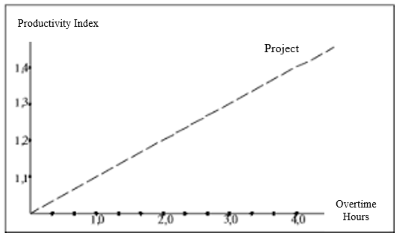Comparison of Additional Working Hours and Additional Labor Based on the Output Value of Construction Projects
DOI:
https://doi.org/10.24036/cived.v10i3.18Keywords:
Earned Value Analysis, Estimation, Delay, Acceleration, Project CrashingAbstract
Quality, time, and cost are three important elements in the project and are interrelated where in its implementation problems can arise that are very likely to occur. One of them is delay. This delay problem also occurs in the Hospital Building Construction Project. In order to find a solution to the problem, this research uses two stages of analysis, namely Earned Value Analysis and Project Crashing on delays experienced by the project in week 17. The results of calculations using the Earned Value Analysis method obtained the value of Schedule Variance (SV) -Rp 146,450,657.32; Schedule Performance Index (SPI) 0.6688; Estimate Temporary Schedule (ETS) 48 weeks; and Estimate All Schedule (EAS) 65 weeks. So, the project that is planned to be completed in 49 weeks is predicted to experience a delay of 16 weeks. Furthermore, scheduling adjustments and analysis of the series of activities carried out with the help of Microsoft Project to determine the critical path. Project Crashing in this study was carried out by comparing two alternatives, namely by adding 4 hours of work (overtime) and increasing the workforce by 30%. Both alternatives can reduce the duration of work for 26 days. The cost required from the acceleration alternative by adding overtime hours is IDR 30,850,351,655.73 with an efficiency of -0.6%. For the alternative of additional labor requires a cost of Rp 30,572,882,563.04 with an efficiency of 0.3%.
Downloads
References
D. Fardila and N. R. Adawyah, “Optimasi Biaya dan Waktu Proyek Konstruksi dengan Lembur dan Penambahan Tenaga Kerja,” INERSIA lNformasi dan Ekspose Has. Ris. Tek. SIpil dan Arsit., vol. 17, no. 1, pp. 35–46, 2021, doi: 10.21831/inersia.v17i1.39499.
Z. R. Kamandang and C. B. Casita, “Delays in Construction Project : A Review,” IPTEK J. Proc. Ser., vol. 0, no. 6, 2018, doi: 10.12962/j23546026.y2018i6.4631.
H. Hassan, J. B. Mangare, and P. A. K. Pratasis, “Konstruksi Dan Alternatif Penyelesaiannya ( Studi Kasus : Di Manado Town Square Iii ),” J. Sipil Statik, vol. 4, no. 11, pp. 657–644, 2016.
M. B. Harefa and A. A. Surbakti, “Pengendalian Pelaksanaan Pada Proyek Jalan dengan Earned Value Analysis,” Juitech, vol. 5, no. 2, 2021.
D. Asmaroni and A. Setiawan, “Penggunaan Metode Nilai Hasil (Earned Value Analysis) Terhadap Biaya Dan Waktu Pada Proyek Konstruksi Bangunan Perumahan (Studi Kasus Proyek Konstruksi Bangunan Perumahan PT. Graha Praja Kencana Di Desa Ceguk Kecamatan Tlanakan Kabupaten Pamekasan),” Ge-STRAM J. Perenc. dan Rekayasa Sipil, vol. 3, no. 1, pp. 31–39, 2020, doi: 10.25139/jprs.v3i1.2439.
I. A. M. Yoni, I. P. D. Warsika, dan I. G. K. Sudipta, “Perbandingan Penambahan Waktu Kerja (Jam Lembur) Dengan Penambahan Tenaga Kerja Terhadap Biaya Pelaksanaan Proyek Dedngan Metode Time Cost Trade Off (Studi Kasus Proyek Pembangunan Gedung Instalasi Farmasi Blahkiuh),” Jurnal Ilmiah Teknik Sipil, vol. 17, no. 2, pp. 129–138, 2013.
Z. R. Kamandang, “The Project Performance Evaluation of Road Construction Project Using Earned Value Method,” Ci-Tech, vol. 3, no. 01, pp. 30–34, 2022, doi: 10.33005/ci-tech.v3i01.53.
A. Pratiwi, A. A. Firdausi, and R. H. Devi, “Pengendalian Waktu dengan Earned Value Analysis pada Proyek Pembangunan Rumah Sakit Jantung dan Pembuluh Darah Kota Tasikmalaya,” vol. 4, no. 2, pp. 76–82, 2022.
R. M. B. Wicaksono, “Analisis Kinerja Biaya Dan Waktu Menggunakan Metode Earned Value Pada Proyek Pembangunan Infrastruktur Laboratorium Tradisional Food Gmp Facility (Paket 3),” Akselerasi J. Ilm. Tek. Sipil, vol. 3, no. 1, pp. 41–49, 2021.
A. Armalisa, D. Triana, and M. M. Sari, “Metode Crashing Terhadap Penambahan Jam Kerja Optimum Pada Proyek Konstruksi,” J. CIVTECH Tek. Sipil Univ. …, pp. 1–18, 2017, [Online]. Available: https://core.ac.uk/download/pdf/327232640.pdf
Y. Stefanus, “Analisis Percepatan Waktu Penyelesaian Proyek Menggunakan Metode Fast-Track Dan Crash Program,” J. Media Tek. Sipil, vol. 15, no. 1, p. 76, 2017, doi: 10.22219/jmts.v15i1.4494.
Y. Putra and S. Hartati, “Optimalisasi Waktu Dan Biaya Menggunakan Metode Least Cost Analysis Pada Proyek Peningkatan Jalan Lingkar Kota Dumai,” J. Saintis, vol. Vol. 17 No, no. April, pp. 100–112, 2017.
Kementrian Tenaga Kerja dan Transmigrasi, “Kepmenakertrans - Waktu Kerja Lembur Dan Upah Kerja Lembur,” vol. 53, no. 9, p. 11, 2004, [Online]. Available: https://jdih.bpk.go.id/wp-content/uploads/2011/03/KepmenNaker102-2004.pdf
R. Pratiwi, S. Mulia Devi, A. Marini, and H. Maya Sari, “Optimasi Waktu Dan Biaya Dengan Metode Time Cost Trade Off (TCTO) Pada Proyek Penambahan Bangunan Pasar Rakyat,” Jurnal Ilmiah Teknik Sipil TRANSUKMA, vol. 4, no. 2, pp. 93–105, 2022.
F. G. A. Ningrum, W. Hartono, and Sugiyarto, “Penerapan Metode Crashing Dalam Percepatan Durasi Proyek dengan Alternatif Penambahan Jam Lembur dan Shift Kerja (Studi Kasus: Proyek Pembangunan Hotel Grand Keisha, Yogyakarta),” e-Jurnal MATRIKS Tek. SIPIL, pp. 583–591, 2017.

Downloads
Published
Issue
Section
License
Copyright (c) 2023 Gati Nuriardani, Zetta Rasullia Kamandang

This work is licensed under a Creative Commons Attribution 4.0 International License.

